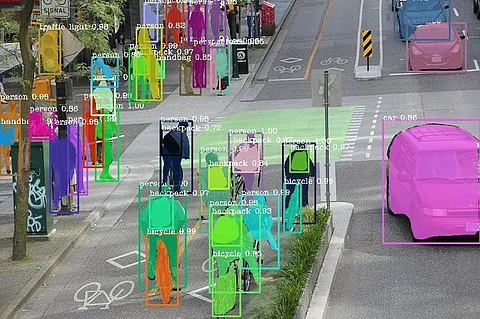

Deep learning has taken a big stand in Artificial Intelligence (AI) technologies. It is successful while working with images as data and constantly proves to be better than humans. One of the major problems that computer vision face is image classification, object detection and segmentation.
However, image annotation is taking the spotlight when it comes to providing the right visual perceptions to machines through computer vision algorithms. Image annotation is a human-powered task of labelling an image with text. These labels are predetermined by the AI engineers. It gives the computer vision model information about what is represented in the image. Semantic segmentation is one of the image annotation used to create the training data for deep neural network. Image segmentation tries to find out accurately the exact boundary of the objects in the image. There are two types of Image segmentation,
• Semantic segmentation
• Instance segmentation
Semantic segmentation is the process of classifying each pixel belonging to a particular label. The technique is a very authoritative method for deep learning as it helps computer vision to easily analyse the images by assigning parts of the image semantic definitions. For example, if there are two dogs in an image, semantic segmentation gives a label to all the pixels of both the dogs.
Remarkably, semantic segmentation plays a vital role in analysing image training through machine learning data using deep learning methods. However, the technique is difficult to carry out as it involves a lot of techniques that are used to create the images with semantic segmentation.
Semantic segmentation aids machines to detect and classify the objects in an image at a single class. It helps the visual perception model to learn with better accuracy for right predictions when used in real-life. There are three types of semantic segmentations that play a major role in labelling the images.
Region-based semantic segmentation is used to separate the incorporates of region-based extradition and semantic-based classification. This type of segmentation uses a free-form region that is selected by the model. The selected regions are transformed into predictions at a pixel level to make sure each pixel is visible to computer vision.
CNN framework or R-CNN is being used to complete this region-based segmentation. The algorithm runs through the CNN, dragging features from every one of these different areas. Another tool named linear support vector machine is used to classify the images with provided details about the subject.
However, there are certain drawbacks in using region-based semantic segmentations.
• This technique is not compatible with the segmentation task.
• The process doesn't contain enough spatial information for precise boundary generation.
• The region-based segmentation takes a long time to complete prolonging the final process.
Convolutional Neural Network (CNN) is a type of deep neural networks that are efficient at extracting meaningful information from visual imagery. It is used for computer vision to perform tasks like image classification, face recognition, identifying and classifying objects, and image processing in robots and autonomous vehicles. CNN is also used in video analysis and classification. It does semantic parsing, automatic captain generation, search query retrieval, sentence classification, etc.
A Fully Conventional Network function can be used to create labels for inputs for pre-defined sizes that happen as a result of fully connected layers being fixed in their inputs. It is created through a map that transforms the pixels to pixels. While FCNs can understand randomly sized images, and they work by running the inputs through alternating convolution and pooling layers, and often the final result of the FCN is it predicts that are low in resolution resulting in relatively ambiguous object boundaries.
Weakly supervised semantic segmentation is the widely used way that creates a large number of images with each segment pixel-wise. The technology comes as a substitute to the manual annotation which will take a lot of time in segmenting images on their pixels. However, weakly supervised semantic segmentation is an expansive process.
Therefore, some weakly supervised methods have been proposed recently, that are dedicated to achieving the semantic segmentation by utilizing annotated bounding boxes. There are different methods for using bounding boxes. This technique uses the bounding boxes to supervise the training of the network and make iterative improvements to the estimated positioning of the masks. Depending on the bounding box data labelling tool the object is annotated while eliminating the noise and focusing the object with accuracy. So, the most commonly used method for semantic segmentation is used as an FCN. It is implemented by taking a pre-trained network with the flexibility to customize various aspects as per the network fitting in the project requirements.
Join our WhatsApp Channel to get the latest news, exclusives and videos on WhatsApp
_____________
Disclaimer: Analytics Insight does not provide financial advice or guidance. Also note that the cryptocurrencies mentioned/listed on the website could potentially be scams, i.e. designed to induce you to invest financial resources that may be lost forever and not be recoverable once investments are made. You are responsible for conducting your own research (DYOR) before making any investments. Read more here.
